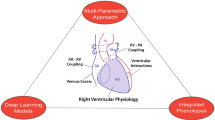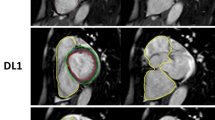Abstract
Right ventricular ejection fraction (RVEF) is an important indicator of cardiac function and has a well-established prognostic value. In scenarios where imaging modalities capable of directly assessing RVEF are unavailable, deep learning (DL) might be used to infer RVEF from alternative modalities, such as two-dimensional echocardiography. For the implementation of such solutions, publicly available, dedicated datasets are pivotal.
Accordingly, we introduce the RVENet dataset comprising 3,583 two-dimensional apical four-chamber view echocardiographic videos of 831 patients. The ground truth RVEF values were calculated by medical experts using three-dimensional echocardiography. We also implemented benchmark DL models for two tasks: (i) the classification of RVEF as normal or reduced and (ii) the prediction of the exact RVEF values. In the classification task, the DL models were able to surpass the medical experts’ performance. We hope that the publication of this dataset may foster innovations targeting the accurate diagnosis of RV dysfunction.
B. Magyar and M. Tokodi—These authors contributed equally to this work and are joint first authors.
B. Merkely, A. Kovács and A. Horváth—These authors contributed equally to this work and are joint last authors.
Access this chapter
Tax calculation will be finalised at checkout
Purchases are for personal use only
Similar content being viewed by others
References
Akkus, Z., et al.: Artificial intelligence (AI)-empowered echocardiography interpretation: A state-of-the-art review. J. Clin. Med. 10(7), 1391 (2021)
Alsharqi, M., Woodward, W., Mumith, J., Markham, D., Upton, R., Leeson, P.: Artificial intelligence and echocardiography. Echo Res. Pract. 5(4), R115–R125 (2018)
Bernard, O., et al.: Standardized evaluation system for left ventricular segmentation algorithms in 3D echocardiography. IEEE Trans. Med. Imaging 35(4), 967–977 (2015)
Chen, Y., Zhang, X., Haggerty, C.M., Stough, J.V.: Assessing the generalizability of temporally coherent echocardiography video segmentation. In: Medical Imaging 2021: Image Processing, vol. 11596, pp. 463–469, SPIE (2021)
Folland, E., Parisi, A., Moynihan, P., Jones, D.R., Feldman, C.L., Tow, D.: Assessment of left ventricular ejection fraction and volumes by real-time, two-dimensional echocardiography. A comparison of cineangiographic and radionuclide techniques. Circulation 60(4), 760–766 (1979)
Lang, R.M., et al.: Recommendations for cardiac chamber quantification by echocardiography in adults: an update from the American society of echocardiography and the European association of cardiovascular imaging. Eur. Heart Jo. Cardiovasc. Imaging 16(3), 233–271 (2015)
Leclerc, S., et al.: Deep learning for segmentation using an open large-scale dataset in 2D echocardiography. IEEE Trans. Med. Imaging 38(9), 2198–2210 (2019)
Ma, N., Zhang, X., Zheng, H.-T., Sun, J.: ShuffleNet V2: practical guidelines for efficient cnn architecture design. In: Ferrari, V., Hebert, M., Sminchisescu, C., Weiss, Y. (eds.) Computer Vision – ECCV 2018. LNCS, vol. 11218, pp. 122–138. Springer, Cham (2018). https://doi.org/10.1007/978-3-030-01264-9_8
Madani, A., Ong, J.R., Tibrewal, A., Mofrad, M.R.: Deep echocardiography: data-efficient supervised and semi-supervised deep learning towards automated diagnosis of cardiac disease. NPJ Digit. Med. 1(1), 1–11 (2018)
Muraru, D., et al.: Development and prognostic validation of partition values to grade right ventricular dysfunction severity using 3D echocardiography. Eur. Heart J. Cardiovasc. Imaging 21(1), 10–21 (2020)
Muraru, D., et al.: New speckle-tracking algorithm for right ventricular volume analysis from three-dimensional echocardiographic data sets: validation with cardiac magnetic resonance and comparison with the previous analysis tool. Eur. J. Echocardiogr. 17(11), 1279–1289 (2015)
Oktay, O., et al.: Anatomically constrained neural networks (ACNNs): application to cardiac image enhancement and segmentation. IEEE Trans. Med. Imaging 37(2), 384–395 (2017)
Ouyang, D., et al.: Echonet-dynamic: a large new cardiac motion video data resource for medical machine learning. In: NeurIPS ML4H Workshop: Vancouver, BC, Canada (2019)
Ouyang, D., et al.: Video-based AI for beat-to-beat assessment of cardiac function. Nature 580(7802), 252–256 (2020)
Porter, T.R., et al.: Guidelines for the use of echocardiography as a monitor for therapeutic intervention in adults: a report from the American society of echocardiography. J. Am. Soc. Echocardiogr. 28(1), 40–56 (2015)
Sayour, A.A., Tokodi, M., Celeng, C., Takx, R.A.P., Fábián, A., Lakatos, B.K. et al.: Association of right ventricular functional parameters with adverse cardiopulmonary outcomes - a meta-analysis. J. Am. Soc. Echocardiogr. https://doi.org/10.1016/j.echo.2023.01.018. in press
Sengupta, P.P., et al.: Proposed requirements for cardiovascular imaging-related machine learning evaluation (prime): a checklist. JACC: Cardiovasc. Imaging 13(9), 2017–2035 (2020)
Shad, R., et al.: Predicting post-operative right ventricular failure using video-based deep learning. Nat. Commun. 12(1), 1–8 (2021)
Tajbakhsh, N., et al.: Convolutional neural networks for medical image analysis: full training or fine tuning? IEEE Trans. Med. Imaging 35(5), 1299–1312 (2016)
Tran, D., Wang, H., Torresani, L., Ray, J., LeCun, Y., Paluri, M.: A closer look at spatiotemporal convolutions for action recognition. In: Proceedings of the IEEE Conference on Computer Vision and Pattern Recognition, pp. 6450–6459 (2018)
Xie, S., Girshick, R., Dollár, P., Tu, Z., He, K.: Aggregated residual transformations for deep neural networks. In: Proceedings of the IEEE Conference on Computer Vision and Pattern Recognition, pp. 1492–1500 (2017)
Zamzmi, G., Hsu, L.Y., Li, W., Sachdev, V., Antani, S.: Harnessing machine intelligence in automatic echocardiogram analysis: current status, limitations, and future directions. IEEE Rev. Biomed. Eng. (2020)
Zhang, J., et al.: Fully automated echocardiogram interpretation in clinical practice: feasibility and diagnostic accuracy. Circulation 138(16), 1623–1635 (2018)
Acknowledgement
This project was also supported by a grant from the National Research, Development and Innovation Office (NKFIH) of Hungary (FK 142573 to Attila Kovács).
Author information
Authors and Affiliations
Corresponding author
Editor information
Editors and Affiliations
1 Electronic supplementary material
Below is the link to the electronic supplementary material.
Rights and permissions
Copyright information
© 2023 The Author(s), under exclusive license to Springer Nature Switzerland AG
About this paper
Cite this paper
Magyar, B. et al. (2023). RVENet: A Large Echocardiographic Dataset for the Deep Learning-Based Assessment of Right Ventricular Function. In: Karlinsky, L., Michaeli, T., Nishino, K. (eds) Computer Vision – ECCV 2022 Workshops. ECCV 2022. Lecture Notes in Computer Science, vol 13803. Springer, Cham. https://doi.org/10.1007/978-3-031-25066-8_33
Download citation
DOI: https://doi.org/10.1007/978-3-031-25066-8_33
Published:
Publisher Name: Springer, Cham
Print ISBN: 978-3-031-25065-1
Online ISBN: 978-3-031-25066-8
eBook Packages: Computer ScienceComputer Science (R0)




